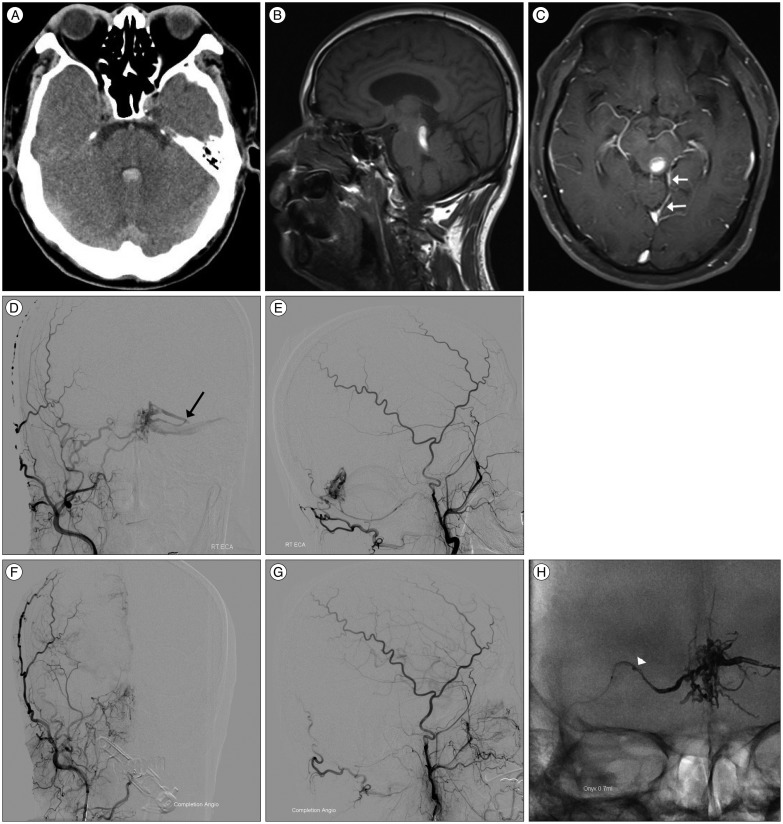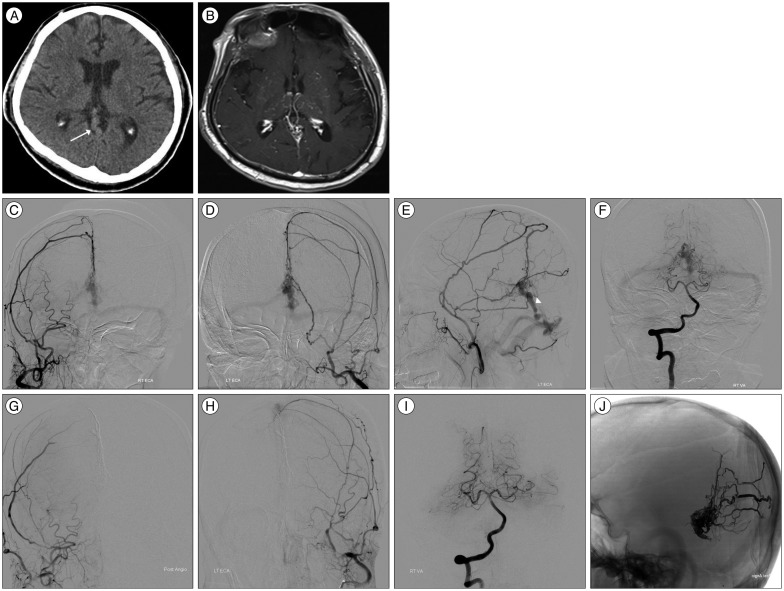J Korean Neurosurg Soc.
2015 Sep;58(3):276-280. 10.3340/jkns.2015.58.3.276.
Tentorial Dural Arteriovenous Fistula Treated Using Transarterial Onyx Embolization
- Affiliations
-
- 1Department of Radiology, Daejeon St. Mary's Hospital, College of Medicine, The Catholic University of Korea, Seoul, Korea.
- 2Department of Neurosurgery, Daejeon St. Mary's Hospital, College of Medicine, The Catholic University of Korea, Seoul, Korea. hyungjin@catholic.ac.kr
- KMID: 2191383
- DOI: http://doi.org/10.3340/jkns.2015.58.3.276
Abstract
- Tentorial dural arteriovenous fistula (DAVF) is a rare vascular disease, which has high risk of intracranial hemorrhage. We present two cases of tentorial DAVF which were successfully treated with single trial of transarterial embolization using Onyx. We briefly reviewed the types of the tentorial DAVF and strategies of treatment.
Keyword
Figure
Reference
-
1. Awad IA, Little JR, Akarawi WP, Ahl J. Intracranial dural arteriovenous malformations : factors predisposing to an aggressive neurological course. J Neurosurg. 1990; 72:839–850. PMID: 2140125.
Article2. Borden JA, Wu JK, Shucart WA. A proposed classification for spinal and cranial dural arteriovenous fistulous malformations and implications for treatment. J Neurosurg. 1995; 82:166–179. PMID: 7815143.
Article3. Cognard C, Gobin YP, Pierot L, Bailly AL, Houdart E, Casasco A, et al. Cerebral dural arteriovenous fistulas : clinical and angiographic correlation with a revised classification of venous drainage. Radiology. 1995; 194:671–680. PMID: 7862961.
Article4. Davies MA, Ter Brugge K, Willinsky R, Wallace MC. The natural history and management of intracranial dural arteriovenous fistulae. Part 2 : aggressive lesions. Interv Neuroradiol. 1997; 3:303–311. PMID: 20678361.
Article5. Gruber A, Mazal PR, Bavinzski G, Killer M, Budka H, Richling B. Repermeation of partially embolized cerebral arteriovenous malformations : a clinical, radiologic, and histologic study. AJNR Am J Neuroradiol. 1996; 17:1323–1331. PMID: 8871719.6. Huang Q, Xu Y, Hong B, Li Q, Zhao W, Liu J. Use of onyx in the management of tentorial dural arteriovenous fistulae. Neurosurgery. 2009; 65:287–292. discussion 292-293PMID: 19625907.
Article7. Hwang G, Kang HS, Oh CW, Kwon OK. Surgical obliteration in superior petrosal sinus dural arteriovenous fistula. J Korean Neurosurg Soc. 2011; 49:222–225. PMID: 21607180.
Article8. Jiang C, Lv X, Li Y, Zhang J, Wu Z. Endovascular treatment of high-risk tentorial dural arteriovenous fistulas : clinical outcomes. Neuroradiology. 2009; 51:103–111. PMID: 18989665.
Article9. Lasjaunias P, Chiu M, ter Brugge K, Tolia A, Hurth M, Bernstein M. Neurological manifestations of intracranial dural arteriovenous malformations. J Neurosurg. 1986; 64:724–730. PMID: 3701421.
Article10. Lawton MT, Sanchez-Mejia RO, Pham D, Tan J, Halbach VV. Tentorial dural arteriovenous fistulae : operative strategies and microsurgical results for six types. Neurosurgery. 2008; 62(3 Suppl 1):110–124. discussion 124-125PMID: 18424975.11. Lewis AI, Tomsick TA, Tew JM Jr. Management of tentorial dural arteriovenous malformations : transarterial embolization combined with stereotactic radiation or surgery. J Neurosurg. 1994; 81:851–859. PMID: 7965115.
Article12. Picard L, Bracard S, Islak C, Roy D, Moreno A, Marchal JC, et al. Dural fistulae of the tentorium cerebelli. Radioanatomical, clinical and therapeutic considerations. J Neuroradiol. 1990; 17:161–181. PMID: 2286839.
- Full Text Links
- Actions
-
Cited
- CITED
-
- Close
- Share
- Similar articles
-
- Dural Arteriovenous Fistula Involving Transverse Sinus: Successful Embolization Using Onyx(R)
- Dural Arteriovenous Fistula Involving an Isolated Sinus Treated Using Transarterial Onyx Embolization
- Hairball-Like Migration of “Onyx Threads” into the Draining Vein during Transarterial Embolization of a Dural Arteriovenous Fistula: A Case Report and Experimental Validation
- A Case of Intraosseous Dural Arteriovenous Fistulas Involving Diploic Vein Treated with Transarterial Onyx Embolization
- Anatomical safety and precaution of transarterial embolization of a falcotentorial dural arteriovenous fistula fed by the artery of Davidoff and Schechter: Case report and review of the literature



